January 18, 2019
Air Date: January 18, 2019
FULL SHOW
SEGMENTS
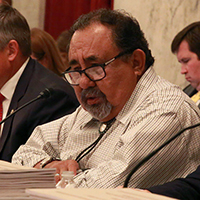
Defending Public Lands
View the page for this story
Rep. Raúl Grijalva (D-AZ) now chairs the House Natural Resources Committee and pledges to defend public lands, endangered species and Native Americans and work to keep fossil fuel deposits owned by the public in the ground. With the new House Democratic majority behind him he also plans to challenge the Trump Administration and probe why former Secretary of the Interior Ryan Zinke decided to shrink Bears Ears and Grand Staircase-Escalante National Monuments in a way that benefits coal and uranium interests. Rep. Grijalva also told host Steve Curwood the committee will address climate change, strengthen fisheries management, and bring science back to federal agency decisions. (08:04)
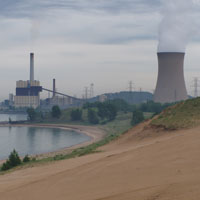
Beyond the Headlines
/ Peter DykstraView the page for this story
This week, Peter Dykstra and Living on Earth’s Bobby Bascomb take a trip beyond the headlines to investigate Northern Indiana Public Service Company's ambitious plan to go coal-free for electric generation within ten years. They also discuss Republican Governor Ron DeSantis’ signing of a bill to protect Florida’s waters. Then, the pair looks back at the 1994 publication of the Citizen's Right to Know list and what happened to it after 9/11. (03:50)
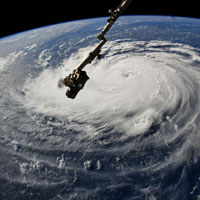
Ocean Warming Speeding Up
View the page for this story
New research published in the journal Science finds that our earth’s oceans are warming 40 percent faster than the IPCC reported in 2013. This means rising sea levels, stronger, wetter and larger storms, and more intense droughts. Kevin Trenberth, Distinguished Senior Scientist with the National Center for Atmospheric Research in Boulder, CO, talks with Living on Earth Host Steve Curwood about these new scientific findings. (09:47)
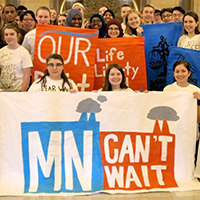
Youth Activists Call for a Minnesota Green New Deal
View the page for this story
Youth activists in Minnesota aren’t waiting to see what may happen with a national Green New Deal. Through a group called Minnesota Can’t Wait, they’re starting a conversation with Governor Tim Walz (D-MN) about transitioning the state away from fossil fuels, while creating clean energy jobs and other sustainable economic growth. Youth activist Lia Harel, a student at Hopkins High School, speaks with Host Steve Curwood about the group’s vision for climate action in Minnesota. (08:04)
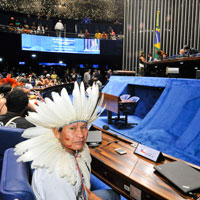
Brazil’s President Targets Amazon
View the page for this story
On his first day in office, Brazil's president, Jair Bolsonaro shifted regulation of indigenous lands in the Amazon rainforest to an agency more friendly to development. Dan Nepstad from the Earth Innovation Institute joins Living on Earth's Bobby Bascomb to talk about possible impacts. (09:34)
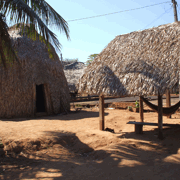
An Amazon Tribe Turns to Modern Technology to Save Their Trees
/ Bobby BascombView the page for this story
In Brazil’s Southwest Amazon region, an ancient tribe is turning to modern technology to save their forest, culture, and perhaps the planet’s climate. The Surui people have preserved their forest for millennia, and in recent years they embarked on a plan to protect it in the future. Living on Earth’s Bobby Bascomb checks back in with how that effort is going. (06:10)
Show Credits and Funders
Show Transcript
190118 Transcript
HOSTS: Bobby Bascomb, Steve Curwood
GUESTS: Raúl Grijalva, Lia Harel, Daniel Nepstad, Kevin Trenberth
REPORTERS: Peter Dykstra
[THEME]
BASCOMB: From Public Radio International – this is Living On Earth.
[THEME]
BASCOMB: I’m Bobby Bascomb.
CURWOOD: And I’m Steve Curwood.
Youth activists in Minnesota want their state to enact a green new deal.
HAREL: What we're trying to emphasize with the Green New Deal is that we're not shutting down our economy in order to save the planet. What we're doing is, we're re-forming our economy in order to keep moving forward and live life in a way that is sustainable.
BASCOMB: Also, Brazil’s new President has shifted protection of indigenous people and their rainforest homes from the justice department to the agricultural ministry.
NEPSTAD: And it's a little bit like giving the keys to the henhouse to the fox, in that he really sort of threw the advantage on the side of those interests that want as little forest land as possible under indigenous control.
CURWOOD: We’ll have those stories and more this week on Living on Earth – Stick Around!
[NEWSBREAK MUSIC: Boards Of Canada “Zoetrope” from “In A Beautiful Place Out In The Country” (Warp Records 2000)]
Defending Public Lands
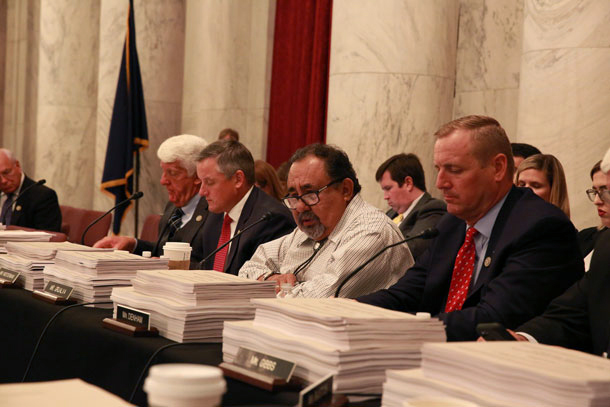
US Rep. Raúl Grijalva (D-AZ) (center) delivered remarks at a Farm Bill hearing in September 2018. (Photo: Flickr CC BY-NC-ND 2.0)
BASCOMB: From PRI and the Jennifer and Ted Stanley Studios at the University of Massachusetts Boston, this is Living on Earth. I’m Bobby Bascomb.
CURWOOD: And I’m Steve Curwood.
Now that the Democrats are in the majority in the US House, the important committee chairs are far more diverse. For example, Arizona Democrat Raul Grijalva is the son of a Mexican farm worker who came to the US through the bracero guest worker program back in the 1940’s. And now after winning his ninth term in Congress he is back in power as chair of the potent House Committee on Natural Resources. He is also the first vice president of the Congressional Hispanic Caucus and co-chair of the Congressional Progressive Caucus. As chair of Natural Resources, Raul Grijalva oversees and holds the purse strings for a broad portfolio of government operations including public lands, mineral resources, species protection and Native American relations. Congressman Grijalva joins us now from his office on Capitol Hill. Mr Chairman, welcome to Living on Earth!
GRIJALVA: Thank you very much. Appreciate the opportunity.
CURWOOD: So you've been in Congress now -- you're in your ninth term. And I believe through pretty much all of this, you've been concerned about natural resources. Why?
GRIJALVA: Well, when I got here, I asked for two committees, natural resources, and education and the workforce, always feeling that they were both very critical committees that unfortunately, they're not considered a top tier exclusive committee. But in terms of the issues that we confront in resources, they're vital, they're important, and I've stuck with it. And through time, and I hope some hard work, I now have the opportunity to lead this committee, and I'm very much looking forward to the opportunity. Somewhat daunting, to say the least given who we're dealing with in this administration, and what has gone on the last two years, but nevertheless, an opportunity to right some wrongs and maybe start to steer the ship in a different direction.
CURWOOD: So tell me, what's your number one priority as you take the helm of the House Committee, or maybe you have a couple of priorities you want to mention?
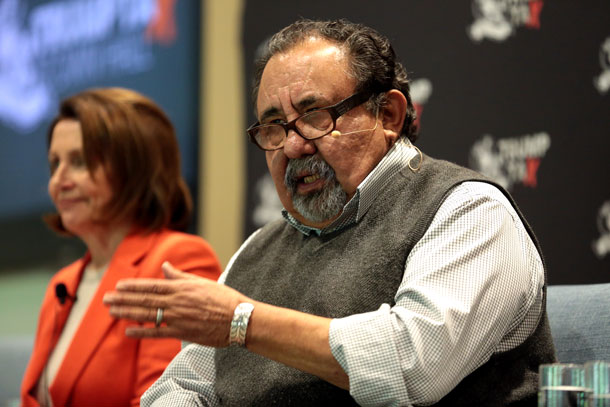
Rep. Grijalva (D-AZ) is Chair of the House Natural Resources Committee. (Photo: Gage Skidmore, Flickr CC BY-SA 2.0)
GRIJALVA: We need to demand accountability, we need to demand oversight, and we need to deal with intended and unintended consequences of the decisions that are being made by this administration internally, with regards to our public lands, our oceans, and all the areas that we have under jurisdiction, from Puerto Rico to indigenous people here in the US. So all the tribal issues that come before us, we have full jurisdiction. And one of the oversight issues that we want to look at is how this administration, and in particular Interior, has suppressed and tried to dumb down the role of science and fact in our decision making. And that applies to climate change. And that applies to species, habitats, water and our public lands. And so raising science once more to the central role, core role that it plays in decision making, especially on this committee, I think is one of the goals.
CURWOOD: The now former Secretary of the Interior Ryan Zinke is out; to what extent is your committee going to look into a number of the decisions that he made? How much of a priority is that now?
GRIJALVA: There's a culture in Interior, a culture that has put oil, gas, extraction industries above any other consideration for our lands, our waters. Mr. Zinke is part of the creation of that culture along with Trump. And so any decision that was made in the last two years, of which Mr. Zinke was -- if not the architect, certainly the functionary for those decisions -- they're open for our scrutiny. We think Bears Ears’ shrinkage and Escalante-Staircase shrinkage, of those monuments are the most apt example of this philosophy of anything goes as long as we are satisfying the interest of those industries. And so we're going to get to how that decision was made. We asked for that information when we were in the minority. Now, we have other legal options to insist to get that information. And Secretary Zinke, either voluntarily or involuntarily, will have to come before this committee and explain how he reached those conclusions and explain to us why it seems that the decisions around there were made to satisfy the mining industry particularly around coal and uranium, and those two monuments at the expense of all the other work that had been done.
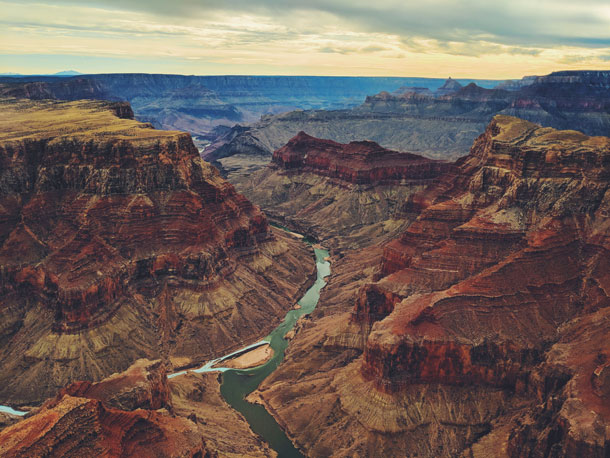
The House Natural Resources Committee has oversight jurisdiction over the nation’s public lands, including its national parks. Grand Canyon National Park, shown here, is in Rep. Grijalva’s home state of Arizona. (Photo: Sonaal Bangera on Unsplash)
CURWOOD: Now, what about the Magnuson-Stevens Act? Now that governs fisheries, both their conservation and management, and I understand that this is a key agenda item for the Natural Resources Committee. Why?
GRIJALVA: I think the discussion in the past when we were in the minority was tilted and many protections that were in about what safe yield is, and the effects of climate change that are going on in the oceans was not factored in at all in those discussions. That is now critical, because as the oceans change, and the life cycle changes for the species, we have to be able to respond to that. And I think by just completely ignoring it, the problem is just going to get worse and worse. So almost anything we do, we're going to have a lot of hearings, and one of them is going to be in that subcommittee, but every subcommittee from Indigenous Peoples of the US subcommittee, to Public Lands subcommittee, to Energy and Power subcommittee, to Oversight, are all going to integrate the issue of climate change and the social and economic costs of not dealing with the question.
CURWOOD: And, I imagine you'll be working then with the Climate Crisis Select Committee?
GRIJALVA: Oh, absolutely. I think hopefully, some joint hearings can occur. But, in our area of jurisdiction, which is pretty vast, these plans have been talked about for many, many years. So we're just going to proceed and coordinate with that committee and make sure that this is not about competition; the more light, the more public understanding and perception we can build around the issue of climate change, and its effect on everyday people and everyday species, regardless, the better off we're going to be. So yeah, we have to coordinate, I think that's all part of it.
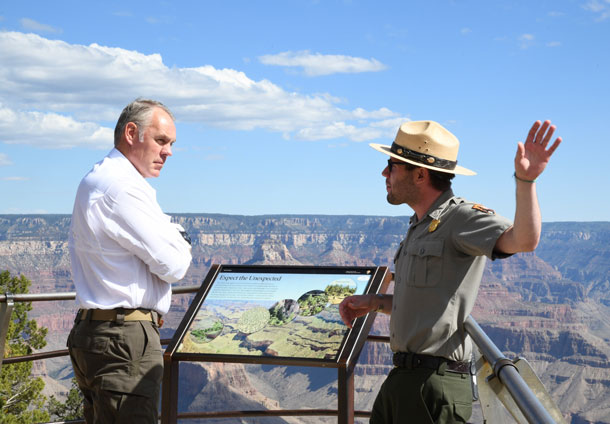
Former Secretary of the Interior Ryan Zinke, seen here with a ranger on a visit to Grand Canyon National Park in September 2018, resigned in December 2018 amid inquiries into his alleged ethical violations. Rep. Grijalva has promised to use his authority as Chair of the House Natural Resources Committee to investigate these alleged ethical lapses. (Photo: U.S. Department of the Interior, Flickr CC BY-SA 2.0)
CURWOOD: You mentioned that it's been a lot of talk about this, what about action? What can be done right now? Of course, you have a Republican Senate, you have Mr. Trump in the White House, you do have the majority now back in the House, what can be done right now to address these issues that you are bringing up?
GRIJALVA: I think at the House level I anticipate we're going to pass some good laws. Magnuson is one that you mentioned. Mining reform, that needs to happen, the only extraction industry that doesn't pay one penny royalty for whatever they take out of the ground and public lands. Then the list goes on, no mitigation fund from the mining industry to take care of abandoned and orphaned mines that are causing problems and dangers throughout the West. And we're going to have significant legislation that profiles and uplifts the needs of Indigenous people here in the United States, tribes that have not been listened to well, the last two years in particular. And so we have a lot of action items that we’ll have. The question I think that people ask -- so you pass it, it goes to the Senate, it goes into some abyss, and it's never heard of again. Or the Senate does something right, and passes something that the House wanted, and it goes to the President, he vetoes. Nevertheless, I think we have a responsibility to the people that gave us this majority to pass that kind of legislation to begin to set the template for 2020. I do feel that we, and Nancy Pelosi knows that, that we have a powerful tool and that's the budget. And from that I think we will be able to negotiate with our Republican colleagues, both in the Senate and the House, changes to the further protect environmental issues, to deal with climate change, because we control the budget.
CURWOOD: Congressman Raúl Grijalva represents Arizona's third district and is the chair of the House Committee on Natural Resources. Congressman, thanks so much for taking the time with us today.
GRIJALVA: Anytime. Thank you very much.
Related links:
- About the House Natural Resources Committee
- Listen to our interview with the Chair of the new House Select Committee on the Climate Crisis
- NYTimes | “Ryan Zinke, Face of Trump Environmental Rollbacks, Is Leaving Interior Department”
[MUSIC: Cliff Eberhardt, “I Want to Take You Home With Me” on 500 Miles, Red House Records]
Beyond the Headlines
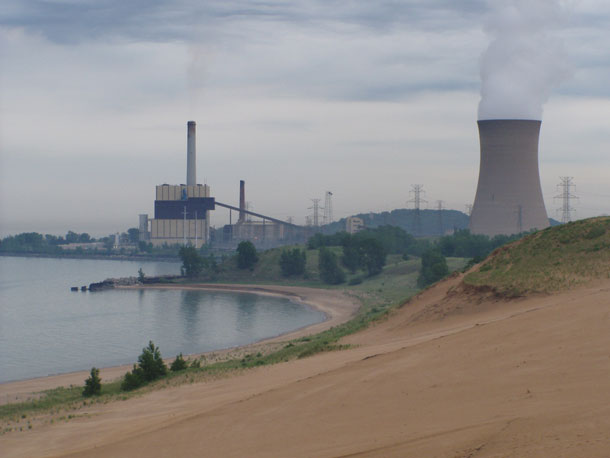
The Northern Indiana Public Service Company plans to have all of its coal-fired power plants closed down in favor of renewable energy generators within 10 years. (Photo: Chris Light, Wikimedia Commons, CC BY-SA 4.0)
BASCOMB: It's time for a trip now beyond the headlines with Peter Dykstra. He's an editor with Environmental Health News. That's EHN.org and DailyClimate.org. Hey there, Peter, how you doing?
DYKSTRA: I'm doing all right, Bobby, hi. I'm going to start off with a groundbreaking announcement from an electric utility that has an ambitious goal to pull off something that seems almost unrealistic, but very promising, in a 10 year period. It's the Northern Indiana Public Service Company, and this delightful acronym of NIPSCO. And NIPSCO announced a commitment to convert from what they are now, which is predominantly coal-based electricity to coal-free electricity, and to do all that in 10 years.
BASCOMB: Wow, that is ambitious. How are they going to get there?
DYKSTRA: They want to leverage renewables, they want to completely end coal consumption, they'll still have some natural gas-generated electricity, and what that means is that they'll cut carbon emissions by 90% and a decade if they meet this ambitious goal.
BASCOMB: Of course, President Trump has famously said he was going to save the coal industry. But I've read recently that more coal-fired power plants have actually closed under Trump, then under Obama in their first term of office. I guess it doesn't bode too well for the coal industry.
DYKSTRA: Yeah, it's a further sign that the domestic market for coal is disappearing. That doesn't always apply to the international market. But going back to NIPSCO, there's a little bit of a catch. They've applied to the state of Indiana for a 12% rate increase. That’s about 100 bucks a year for the average ratepayer. That's what they say they are going to need to pull this off, but let's see if they can deliver on this really ambitious target.
BASCOMB: Um, what else do you have for us this week?
DYKSTRA: Here's something that may be positive news. The new Governor of Florida is a Republican named Ron DeSantis. You may remember he won a very, very tight race for Governor back in November. When he was a congressman, Ron DeSantis racked up a 3% lifetime score from the League of Conservation Voters, so any expectations that Floridians had for environmental goals were really, really low. But here's what he did in his first week in office. He signed an executive order that steered $2.5 billion toward protecting Florida's water resources, mainly the Everglades.
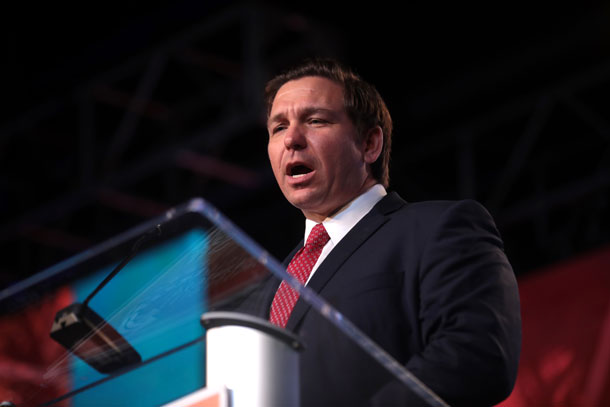
Republican Florida Governor Ron DeSantis recently signed an executive order that gives $2.5 billion to protect the Everglades. (Photo: Gage Skidmore, Flickr, CC BY-SA 2.0)
BASCOMB: Wow. Well, that's a great first step. I mean, doesn't exactly make him a tree hugger, but his predecessor Governor Rick Scott actually banned any discussion of climate change under his administration. So, I guess, baby steps?
DYKSTRA: He did. And Rick Scott is no longer Governor because he's now Senator Rick Scott. So he's got a whole new platform from which to talk climate denial.
BASCOMB: Right, right. Well, what do you have for us from the history vaults this week?
DYKSTRA: Here's a 25th anniversary. January 18, 1994, the EPA published something called the Citizen’s Right-to-Know list. There had been years of pressure not just from advocacy groups, neighbors of industrial facilities, fire departments, and other public safety people who wanted to know exactly what hazardous materials facilities were storing, or using, or emitting in their neighborhood. But then a few years later, along came 9/11, and there was a big push from industry to make all that information secret again. Their argument, or their fear was the chemical information could fall into the hands of terrorists. They didn't want it to fall into the wrong hands. But now such information has a much harder time falling into the right hands.
BASCOMB: Right, yeah, seems like first responders, at the very least, should know what they're up against when they get called to a situation. Well, thanks for those updates, Peter. Peter Dykstra is an editor with Environmental Health News, that’s EHN.org, and DailyClimate.org. We’ll talk you again real soon, Peter.
DYKSTRA: Okay, Bobby, thanks a lot. We'll talk to you soon.
BASCOMB: There’s more on these stories at our website, LOE.org.
Related links:
- North American Windpower | “Indiana’s NIPSCO Plots Coal Phaseout, Transition To Renewables”
- Orlando Weekly | “Ron DeSantis Signs Executive Order Calling for $2.5 Billion for Everglades Restoration, Toxic Algae Task Force”
- Environmental Protection Agency Archive | “EPA Administrator Carol M. Browner Issues Citizen Right-To-Know List of Toxic Chemicals”
[MUSIC: Chet Baker, “I’m Glad There Is You” on My Funny Valentine, by Dorsey/Madeira, Pacific Jazz]
CURWOOD: Coming up – Youth activists in Minnesota demand a Green New Deal for the land of 10,000 lakes. That’s just ahead on Living on Earth. Don’t touch that dial!
ANNOUNCER: Support for Living on Earth comes from Sailors for the Sea and Oceana. Helping boaters race clean, sail green and protect the seas they love. More information at sailors for the sea dot org.
[CUTAWAY MUSIC: Chet Baker, “I’m Glad There Is You” on My Funny Valentine, by Dorsey/Madeira, Pacific Jazz]
Ocean Warming Speeding Up
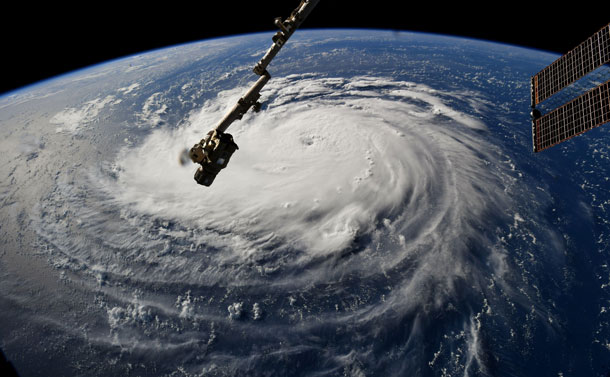
In September 2018 the unusually long duration of Hurricane Florence led to severe flooding in the Carolinas. (Photo: NASA, Wikimedia Commons CC)
BASCOMB: It’s Living on Earth, I’m Bobby Bascomb.
CURWOOD: And I’m Steve Curwood.
New research published in Science Magazine finds that the world’s oceans are getting warmer at a much faster rate than the Intergovernmental Panel on Climate Change reported back in 2013. This latest research used updated scientific instrumentation and modeling to recalibrate past data. The oceans play a dominant role in the Earth’s weather in a number of ways, from brewing storms to creating El Niños. In fact, a mild El Niño likely began in December, and it could bring soaking rains to the California coast while at the same time it worsens drought in Australia, which is now in the grip of an epic heat wave. Warmer oceans lead to bigger, longer and stronger storms and it will take centuries for the seas to cool down even if emissions of heat-trapping gases such as carbon dioxide and methane are eventually reduced. Kevin Trenberth, a Distinguished Senior Scientist with the National Center for Atmospheric Research in Boulder is a co-author of the study. Kevin, thanks for joining us!
TRENBERTH: You're most welcome.
CURWOOD: So Kevin, bottom line is, is that the ocean is getting hotter, some 40% faster than what had been previously thought, huh?
TRENBERTH: That's correct. And especially in recent times. So the main period we talked about in the record in the paper, based upon the IPCC report was from 1971 to 2010. And of course, we can go right up to the present in the new record. And so the record, not only are the values higher, but there's clear evidence of an accelerating rate. So, the oceans are warming faster now than they used to be.
CURWOOD: Faster and faster. What does that mean, in terms of actual temperature rise?
TRENBERTH: A lot of the deep ocean is changing by very small amount, so only a few hundredths of a degree Celsius and so the deep ocean is warming by very tiny amounts. The surface ocean as a whole has warmed by, a little over one degree Fahrenheit, and the air above the oceans has about five to 10% more water vapor. As a consequence of that the air is warmer, and it's moisture. And it's best to think of it that way. Because one degree Fahrenheit produces air that can hold about 4% more moisture on average. And we're finding in general that this five to 10% number is about what we're seeing over the global oceans. So this is what feeds the storms, and leads to immediately a five to 10% increase in rainfall. But that increase in rainfall also means that the heat that went into evaporating the moisture in the first place is released, that heat gets released into the storm, and it can invigorate the storm. And so you can easily double that amount. So it can easily convert into 15 to 20% increase in rainfall. And some of the experiments that have been done using models of different kinds suggest that in the case of Harvey, for instance, that there was about a 30% increase in the rainfall as a consequence of the warming of the oceans and the climate change.
CURWOOD: So where are the temperatures rising the most in the oceans?
TRENBERTH: We have maps of that actually, and some of the biggest warming is occurring over the southern oceans. That's a region where there are strong winds and the heat gets carried down. It's also warming quite substantially throughout much of the Atlantic Ocean, and including the North Atlantic.
CURWOOD: What implications could this dramatic temperature acceleration that you're now able to observe, what does that mean for sea level rise?
TRENBERTH: So sea level has gone up by about 30 millimeters relative to the average, from 1970 to 2010. In recent times, we've had altimeters in space, that are measuring sea level, to millimeter accuracy. And so the rate of increase of sea level is about 3.1 millimeters per year. So if you think of 3.1 millimeters, think of a foot ruler, that's about 30 centimeters. And so this is a little over a foot per century, if you like to think of it that way. That's the current rate of sea level rise. And so we can estimate now how much sea level has risen from the expansion of the ocean.
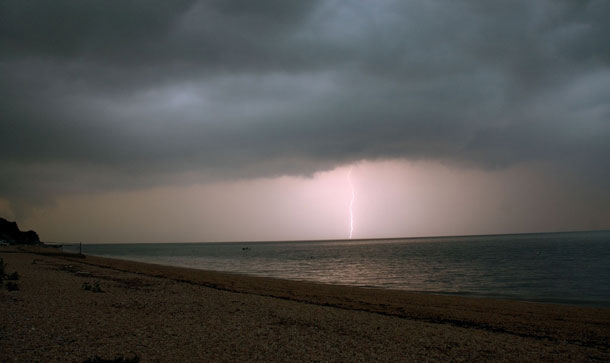
Warming oceans can increase the intensity of storms. (Photo: Dr. DeNeo, Flickr, CC BY-NC-ND 2.0)
CURWOOD: Gee, a foot per century doesn't sound very bad.
TRENBERTH: That's only a part of the sea level rise overall, of course. The other part, a slightly larger part, is the melting of glaciers and Greenland and Antarctica, which is contributing also to sea level rise. And, so, the total sea level rise is maybe three times that.
CURWOOD: And, now how are these rising ocean temperatures affecting our weather?
TRENBERTH: So some spots of the ocean get warmer than others because of the weather events over the past year. And one of the warmest spots in 2018 was off the coast of the Carolinas, which is where Florence developed. And that led to tremendous flooding and a very slow moving storm that caused a tremendous amount of problems in that area. The previous year, 2017, one of the warmest spots was in the Gulf of Mexico, where Harvey developed and indeed led to tremendous flooding in the Houston area. And we've been able to show indeed, that there's a direct relationship there between the heavy rainfalls and the ocean heat content.
CURWOOD: Whoa, so wait a second, we're talking about in the Paris deal keeping warming below one and a half degrees centigrade. So you know, my math is a little wobbly, but we're talking say two and a half degrees Fahrenheit, 2.7, maybe; we're getting a 15, 20% increase in storm strength, just from that one degree Fahrenheit, what would the world be like if we were to hit that target that's been talked about for Paris?
TRENBERTH: Well, this is indeed, what we're seeing around the world, is that the dry spots, the places where it's dry, things are drying out a little more, increasing the risk of wildfire, but then the moisture that is being evaporated, gets carried around and converges into the locations where the storms form. And so that's a key reason why that amplification occurs; rather than 5% change, you immediately get a 10% change. And then the lifetime of the storm is another key factor and the size of the storm is the other factor that can easily get you up to something like maybe a 30% change when you take all of those factors into account. And so the storms sort of reach out and grab all of the available moisture in the area, bring it into the storm and drop it down in the form of rainfall. And so we've got very good evidence that when it rains, it rains harder. And that's especially true along the east coast, and especially the Northeast.
CURWOOD: Now we have seen the Trump administration shut down the government for extended periods of time. And among other things that have happened in the course of that is that a lot of scientific research has gotten halted and maybe in certain cases information’s being lost. How do you think the stuttered financing of our climate research is putting us at risk, especially in terms of climate change?
TRENBERTH: Oh, it's certainly affecting the information flow and putting at risk a lot of observations. NOAA is an extremely important agency in this regard for maintaining the buoys out in the tropical Pacific that track the El Nino phenomenon. And firstly, they are probably not tracking whether the buoys are performing adequately or not. And they're often subject to vandalism and natural problems that occur. And we have no way of tracking whether the information is flowing properly at the moment. There is a small core of people at the Climate Prediction Center and NOAA who are working to put out reports on a weekly basis as to how the current El Nino is developing. I think they're running maybe at about 50% of the people there. But that means the in-depth analyses are not occurring and the ability to fix any problems that occur is certainly not there. So this is quite worrying, because this can have repercussions down the line.
CURWOOD: Yes, as you said, it’s been important to go back and look at data that was gathered in different ways and if you have gaps in data that makes things very difficult.
TRENBERTH: Yes, observations that are not taken are lost forever. We cannot go back and redo those.
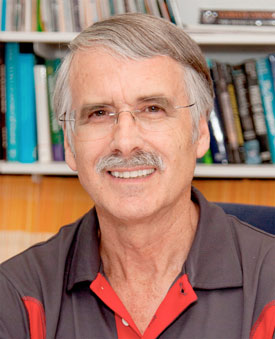
Kevin Trenberth is a Distinguished Senior Scientist with the National Center for Atmospheric Research. (Photo: National Center for Atmospheric Research)
CURWOOD: You've been doing this research for a number of years. How do you feel about what we're seeing now?
TRENBERTH: Well, it's quite worrying. There’ve been a number of reports that have come out recently, some from the National Climate Assessment in the United States, and also the Intergovernmental Panel on Climate Change, and there’s a more complete IPCC report underway as a next major assessment as to what's going on on a worldwide basis. They have been consistently shouting out a warning that we're headed for, potentially an increase of two degrees Celsius, which has been a metric in the Paris Agreement, for instance, saying that we really should not get to that level if we possibly can, in terms of the global mean temperature increases, because going along with that is a whole lot of very disruptive effects and potentially dislodging ecosystems. And there are many consequences that get progressively worse. The sort of things we've already talked about increase substantially. And about that level, food shortages and water shortages could become very widespread. So we need to avoid that if we possibly can. In addition, we need to plan for these things and build resiliency, and we're not really doing enough of either, especially under the Trump administration.
CURWOOD: Kevin Trenberth is a distinguished senior scientist with the National Center for Atmospheric Research. Thanks for taking the time with us today. Kevin.
TRENBERTH: Well, thank you very much for having me.
Related links:
- Science Magazine | “How fast are the oceans warming?”
- More about Kevin Trenberth and his work
[MUSIC: Ma Kru, “Palabras” on Tu Mission, self-published]
Youth Activists Call for a Minnesota Green New Deal
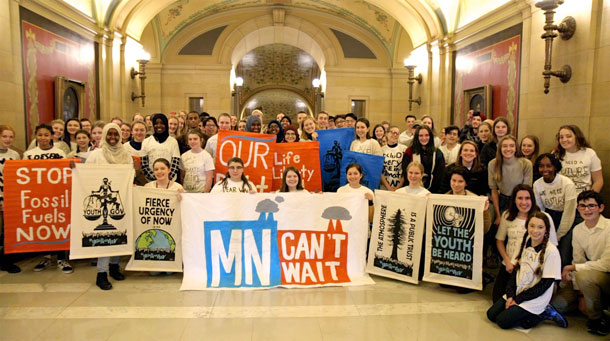
Minnesota Can’t Wait youth activists held a rally at the Minnesota State Capitol on January 9, 2019. (Photo: Devon Cupery)
CURWOOD: Social change often comes in America through the states, whether it was Wyoming that first gave women the vote or the Massachusetts Supreme Judicial Court that ruled gay people have the right to marry. Today a group of high schoolers in Minnesota are pushing that state to become the first to enact a Green New Deal, to address the climate crisis with a progressive social and economic agenda. Nationally more than 600 environmental groups have together called for a Green New Deal, but so far there has been no federal action. Meanwhile a youth group called Minnesota Can’t Wait recently planned a sit-in at the Minnesota’s governor’s office that morphed an alliance with the governor and lieutenant governor to develop actual legislation that would implement a Green New Deal. One of those young activists is Lia Harel. She’s a senior and environmental club leader at Hopkins High School, and in iMatter, a youth climate action advocacy group. She joins me now from Minnetonka. Lia, welcome to Living on Earth!
HAREL: Hi, thank you for having me.
CURWOOD: Lia, why did you decide to get involved in climate advocacy?
HAREL: Well, I began climate advocacy not too long ago. When I was a sophomore, I joined my high school's Earth Club. And I came in expecting to talk about saving the polar bears and picking up trash in the community. And I quickly recognized that climate change, and environmental justice issues, impact so many more sectors of our society, you know, our public health, our food security, our infrastructure and economy. And I had this major epiphany moment, that this is the reality and the reality is threatening my future.
CURWOOD: Tell me how you help form your Minnetonka Climate Initiative.
HAREL: Well, my high school’s Earth Club, we heard about some great work that other high schoolers were doing in neighboring schools with iMatter and we wanted to do something in Minnetonka as well. And so Hopkins High School partnered with Minnetonka High School, like an neighboring community, and we presented to the city our research on what we think the city is doing at addressing climate change. And we recognize that while the city is taking great steps, there are still more that can be done. Right now, we don't have any type of Climate Action Plan that would lay out how we're going to address reducing our emissions and transitioning to more renewable electricity. And specifically, the goals of what we want in a climate action would be that our city would transition to 100% renewable electricity by the year 2030, and have net zero greenhouse gas emissions by 2040. And right now we're in the process of working with the city and seeing how we can put those asks into action.
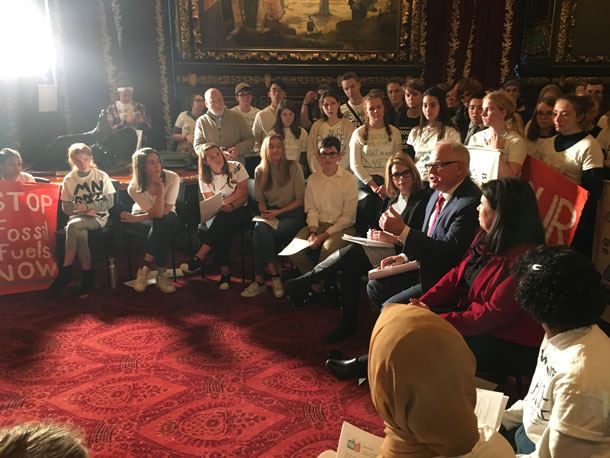
On January 9, 2019, over 100 youth activists with the organization Minnesota Can’t Wait met with Governor Tim Walz to demand state action on climate change. (Photo: courtesy of iMatter)
CURWOOD: Now, I understand you've gone to the state level where you're doing some advocacy with the group Minnesota Can't Wait; please tell me briefly about what the Minnesota Can't wait proposal is and what that all involves.
HAREL: So the Minnesota Can't Wait movement is a youth-led movement with support from other organizations such as iMatter and Climate Generation. And we have three main points of our platform. So the first main point is for executive action from Governor Walz to regulate statewide greenhouse gas emissions. The second point is for no more fossil fuel infrastructure, such as the Line 3 pipeline. And the third point is for a Minnesota Green New Deal bill, which aims at creating an equitable transition to a sustainable economy.
CURWOOD: Let's talk about those. So far how is the governor, Governor Walz, responding to your request to regulate greenhouse gases?
HAREL: Well, actually, just recently, on January 9, we had a huge event and we had 100 to 150 youth come to his office, and we had a meeting with him, along with the Lieutenant Governor and the Pollution Control Agency Commissioner, and we sat down and we had a few speeches and inspiring stories from young climate activists. And we very specifically stated, how are you going to follow up with your commitment to prioritize climate action? And how are you going to start taking action on regulating greenhouse gas emissions? And he made a point to emphasize that, yes, climate change is very important to his administration, and we're looking forward to continuing the conversation and collaborating with them.
CURWOOD: Now, your second point was you want to transition to a renewable economy, no more fossil fuels.
HAREL: Correct.
CURWOOD: Okay. How do you do that?
HAREL: Well, it's definitely a complicated task. And again, I'm not the expert, but it's definitely something that we need to do. And so we need to stop investing in more projects that continue our dependency on fossil fuels, such as Line 3, that would transport crude oil through Minnesota and through Mississippi headwaters and Native American treaty land. And right now, in order to stop our dependency, we need to divert our money into investments of renewable energy as soon as possible.
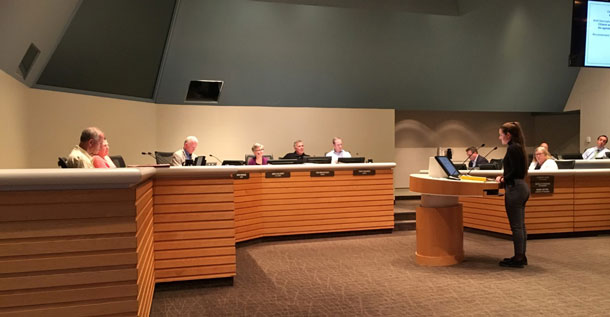
Youth activist Lia Harel addressed the Minnetonka City Council on April 30, 2018 as part of a Minnetonka Climate Initiative effort to call for city actions to address climate change. (Photo: courtesy of iMatter)
CURWOOD: Now on the Green New Deal, what's the specific piece of legislation that you're crafting for the Minnesota Green New Deal?
HAREL: Well, the policies we’re still right now outlining; we're drafting the bill currently, and the specifics of it are not laid out. But if we think about the term Green New Deal, the words New Deal refer to FDR's economic stimulus package. And what we're trying to emphasize with the Green New Deal is that we're not shutting down our economy in order to save the planet. What we're doing is we're reforming our economy in order to keep moving forward and live life in a way that is sustainable.
CURWOOD: Now, FDR's New Deal had, yes, an economic component. But it was also very much a social change component, to give people living wages, to change the way things had been done. But to what extent in your mind does a Green New Deal, talk about changing the way that as a society, we relate to each other, as well as just the money?
HAREL: Well definitely we've seen with the national Green New Deal, there's been quite an emphasis on making sure that we're incorporating all voices into the conversation. So people of color, marginalized communities, Indigenous peoples, making sure that as we're creating a transition, we're not leaving people behind. And yes, there's that social aspect, because in order to address a lot of social issues, environmental issues are directly related with that.
CURWOOD: What special advantages do you think Minnesota has in moving ahead with its own Green New Deal? You folks are known for being so polite.
HAREL: [LAUGHS] Well, yes, we're polite, but we're stern. And I think Minnesota is already a leader in a lot of climate related policies. And we can continue to be a leader and we can be a model for other states. These policies and these social justice issues are coming about through state action, because that is the way that we can inspire each other. It's not all of a sudden, everyone at once understands an issue, it takes time, and it takes gradual transitions, but transitions that actually do happen in order to bring about that change.
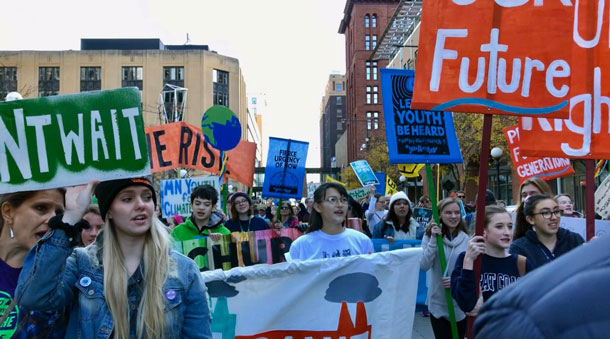
Youth leaders from iMatter and partnering environmental organizations held a rally and march to the Minnesota State Capitol on October 28, 2018 in solidarity with the Juliana v. United States plantiffs. The youth plaintiffs are suing the federal government for allegedly violating their constitutional rights by contributing to climate change. (Photo: courtesy of Lia Harel)
CURWOOD: Who inspires you most in this movement? Or who are a few people who inspire you a lot in this movement?
HAREL: You know, I think it's the young people. I have a friend who has been working on these issues since she was very young. There's a 13 year old in this movement. And I'm just amazed; you know, none of us really think of our age as something that limits what we think we're able to do. We all see each other as human beings, and we all value each other. And I think sometimes it's not always easy for people to see why it's important now, and you know, you can show people the facts and the figures, but that doesn't really stick with them. But when you hear the calls of young people asking for a change, and to make sure that our future is healthy, then why shouldn't we start now? Why should we wait to do this? What is the benefit of waiting if the more action we take now, the brighter our outcome.
CURWOOD: Lia Harel is a senior at Hopkins High School in Minnetonka, Minnesota. Lia, thanks so much for taking the time with us today.
HAREL: Yeah, thank you very much.
Related links:
- Grist | “Minnesota youth demand Green New Deal in meeting with governor”
- Minnesota Can’t Wait
- Lia Harel is a youth leader with the Minnetonka chapter of iMatter
[MUSIC: Travi$ Scott, “A-Team,” Epic Records 2016]
BASCOMB: Just ahead, threats for the Amazon rainforest from the new president of Brazil. Keep listening to Living on Earth.
ANNOUNCER: Funding for Living on Earth comes from you, our listeners, and United Technologies, combining passion for science with engineering to create solutions designed for sustainability in aerospace, building industries, and food refrigeration. UTC companies such as Otis, Carrier, Pratt and Whitney, and UTC Aerospace systems are helping to move the world forward. You can learn more about United Technologies by tuning into the Race to Nine Billion podcast; listen at racetoninebillion.com. This is PRI, Public Radio International.
[CUTAWAY MUSIC: Joshua Messick and Friends, “Ancient Roots”]
Brazil’s President Targets Amazon
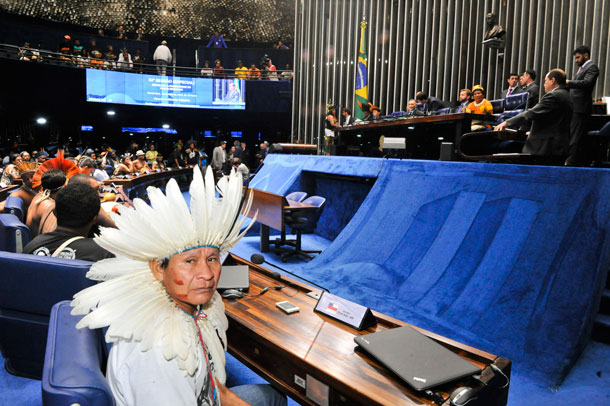
The Brazilian Constitution grants indigenous Brazilians exclusive possession of their traditional lands. However, the ability to demarcate and regulate these territories has recently been handed over to the Brazilian agricultural ministry. (Photo: Waldemir Barreto, Agência Senado, Flickr, CC BY 2.0)
CURWOOD: It’s Living on Earth, I’m Steve Curwood.
BASCOMB: And I’m Bobby Bascomb.
On his first day in office Brazilian President Jair Bolsonaro gave the Brazilian Ministry of Agriculture provisional power over the territories belonging to Indigenous peoples and the descendants of runaway slaves. Critics say this is a dangerous move. Most of these lands are located in the delicate Amazon rainforest. And many worry that this move will result in more deforestation and a weakening of Amazon protection. To explain is Dan Nepstad, Executive Director and Senior Scientist for the Earth Innovation Institute. Dan, welcome back to Living on Earth.
NEPSTAD: Thank you.
BASCOMB: So what exactly does President Bolsonaro's provisional measure entail?
NEPSTAD: Well, he came in on a campaign of basically freeing Brazil up from regulations, not unlike the President of the United States. And one of the historical debates in the Amazon especially is, how much land should indigenous groups have of their ancestral land. And that historic battle, his solution to it was to take the responsibility of defining and officially demarcating those indigenous territories from the Indigenous Institute in FUNAI, which is designed for that purpose. And he gave it to the agricultural ministry called MAPA. And it's a little bit like giving the keys to the hen house to the fox in that he really sort of threw the advantage on the side of those interests that want as little forest land as possible under indigenous control.
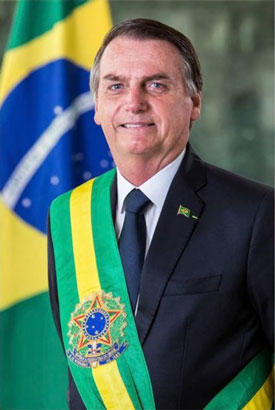
Jair Bolsonaro was sworn into office as president of Brazil on January 1, 2019. (Photo: Palácio do Planalto, Wikimedia Commons, CC BY-SA 4.0)
BASCOMB: So what was the role of FUNAI previously, and how will that work be done differently now, under the agricultural ministry?
NEPSTAD: What FUNAI has been doing over the years is there will be a very long process of defining the appropriate boundaries of indigenous territories and then having those formerly demarcated so that basically they're off limits to development. And now MAPA is responsible for that job. And the concern is that the many indigenous territories that are in the queue will now be dead in the water. And worse, that some that are quite far along the process could actually be reversed. Brazil has an enormous agribusiness sector, it's now about one fourth of the nation's economy. It's the main source of trade balance of payments. And that is all under the jurisdiction of the Ministry of Agriculture and Livestock Production, MAPA, and it remains to be seen how they will implement this new function.
BASCOMB: Can tell me a bit about the indigenous population in Brazil? I mean, where do they live, and how many people or tribes are estimated to be living there?
NEPSTAD: Brazil has got a couple of hundred indigenous languages, most of those are in the Amazon. And it's got one of the world's greatest diversities of indigenous people. In addition to indigenous people, there’re also traditional folks who've been living in forests for a century or more, and include colonies and communities of escaped slaves. And all of those people with these historical claims on land and forests are at risk right now. So the actual exact number of indigenous folks, that's about a million people.
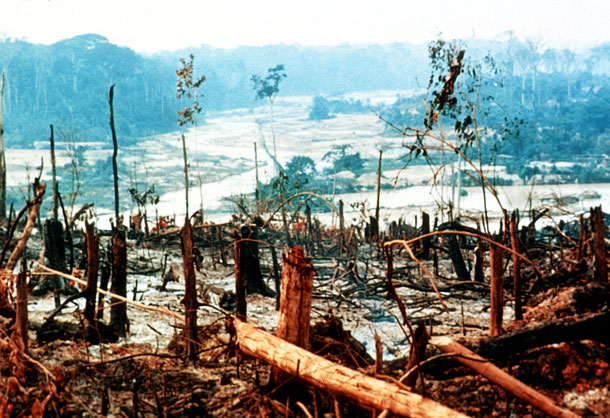
Only about 80% of the original Amazonian forest cover present in 1970 remains in 2019. (Photo: Oregon State University, Flickr, CC BY-SA 2.0)
BASCOMB: I read a recent tweet from President Bolsonaro in which he said, “Less than 1 million people live in those places, isolated from the real Brazil; they are explored and manipulated by nonprofits. Together, we will integrate those citizens and give value to all Brazilians.” That sounds to me like President Bolsonaro thinks he's doing these people a favor by integrating them into Brazilian society, what do you make of that?
NEPSTAD: There is a whole narrative that indigenous people are primitive, they’re malnourished, they're under educated, they don't get proper health care. And in many cases, that's true. But I would point the finger at the federal government for those lack of services more than the fact that indigenous people are controlling their own destiny. There's, I think, a hunger among many indigenous people to have a better income, just to keep their people healthy, and their customs alive and their ceremonies going. And just in the last six months, I've been approached by some indigenous leaders really just saying, Listen, we have our territory now. But we need a source of income. And so I think there is needed economic alternatives for many of these indigenous groups.
BASCOMB: There are loads of studies and research that show the best way to protect rainforest is to empower the indigenous people living there. I mean, I've seen maps where they overlay a healthy rainforest and indigenous populations and they just overlap exactly.
NEPSTAD: We've done some of those studies and you're exactly right.
BASCOMB: How will this change affect the ability of indigenous people to protect their land?
NEPSTAD: That's something that's very much up in the air. One of the sort of bright spots right now – [GECKO CALLS] sorry, there's our gecko in the background. There's a new set of partnerships between indigenous organizations -- the organizations that represented indigenous groups -- and state governments. And amazing progress, in sort of bringing those indigenous leaders to the table so that they are part of the policy process and they're saying what they need; that includes those economic alternatives that I was mentioning earlier. You know even as Bolsonaro cracks down and weakens FUNAI we have some signs of hope that indigenous people who will be getting some of the support they need and a stronger voice in the policies that define the future of their region through these state level partnerships.
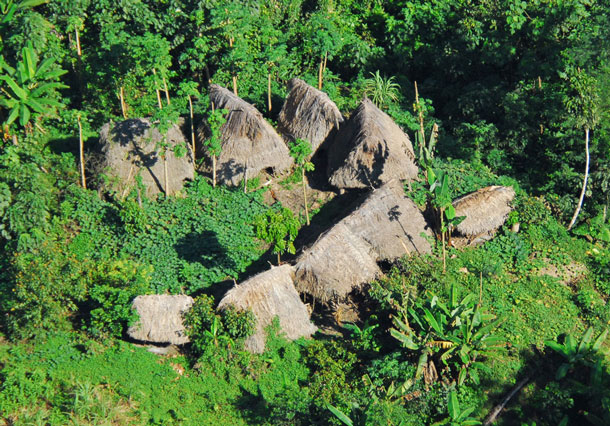
In addition to nearly a million recorded indigenous Brazilians, there are still a number of uncontacted peoples who live deep in the Brazilian Amazon. (Photo: Gleilson Mirando, Governo do Acre, Wikimedia Commons, CC BY 2.0)
BASCOMB: Now, of course, the Amazon is already a stressed ecosystem, there's talk of a tipping point; after a certain amount of deforestation, there's just not enough forest left to keep the whole system thriving. How likely actually, is that do you think? And how close are we to something like that, especially in light of the changes that President Bolsonaro would like to make.
NEPSTAD: I think we are fairly close. In a normal year, an Amazon forest doesn't catch fire if it hasn't been disturbed. So under severe drought, fires move into those forests that kill trees. And then that forest is susceptible to further burning, even when it's not severe drought. So that sort of perfect storm of conditions is coming together more and more frequently. And we could be looking at just a huge, sort of a die back driven by fire and drought. Where the exact number is, you know, I think, to be cautious, we shouldn't go below 80. And we should have a big reforestation campaign right now. But the science, falls between, 65-80 as to where that tipping point is.
BASCOMB: Is 65 to 80% of the forest intact?
NEPSTAD: Of the original forest?
BASCOMB: Yeah.
NEPSTAD: Yeah, so we're at 80 now. And if we lose, go down to 70, the chances of a major tipping point are considerably higher. A lot of it depends on, climate change itself, and how quickly the heating takes place, and the sort of extreme weather events more than sort of the average temperature. And if we keep getting these very weird droughts in the Amazon, then I think, maybe 80 isn’t enough.
BASCOMB: Well and of course, it's a feedback system, right? So if you have climate change, which is making hotter temperatures, and it's drier in the Amazon, you have forests dying, that exacerbates climate change because, you don't have those trees, sucking carbon dioxide out of the air, I mean, it's a, it's a terrible runaway system.
NEPSTAD: Exactly, yep. And even if we make huge progress in coal-fired electricity, and etc, we could still not win the war. The best estimates right now are that tropical forest globally, you know, slowing the loss and speeding the recovery, where they're already gone, could be about a fourth or a third even of what is needed by 2030 to avoid the really dangerous impacts of climate change. And they're getting about 3% of the finance, so it's this big mismatch globally in terms of the potential importance of tropical forests for avoiding climate change, and the level of attention and finance flowing to them.
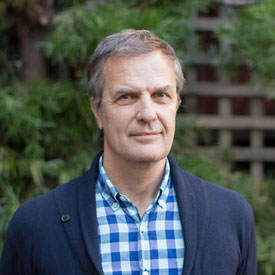
Daniel Nepstad is the President and Founder of Earth Innovation Institute. (Photo: Courtesy of Earth Innovation Institute)
BASCOMB: Is there any reason to be optimistic here? I mean, can the Amazon outlast one president?
NEPSTAD: I am optimistic, actually. And that being, cause I think, similar to the climate change debate in the United States, people are seeing why climate change is important, and why we need to solve it with their own eyes, despite the climate deniers, despite the rhetoric saying how it's holding back our economy. In Brazil, more and more people are seeing the advantages of having forests. And when forests are falling, your kid has a much higher likelihood of having bronchitis. When forests are falling and being burned, airports are closed and transmission lines are getting burned. And there is a growing sense that Brazil has made a huge achievement and let's consolidate that achievement and really be proud about the Amazon. And I think if conservation strategies tap into that hope, Brazil will contain the Bolsonaro presidency.
BASCOMB: Daniel Nepstad is executive director and senior scientist for the Earth Innovation Institute. Thanks for taking the time with me today, Dan.
NEPSTAD: Thank you. It's my pleasure.
Related links:
- Global News | “Brazil’s New President Makes It Harder to Define Indigenous Lands”
- CNN | “Why Brazil’s Jair Bolsonaro Has Environmentalists Worried for the Amazon”
- Earth Innovation Institute
[MUSIC: Carmen PI, Ela é Carioca on “Sol de Bossa”, Rambling Records]
An Amazon Tribe Turns to Modern Technology to Save Their Trees
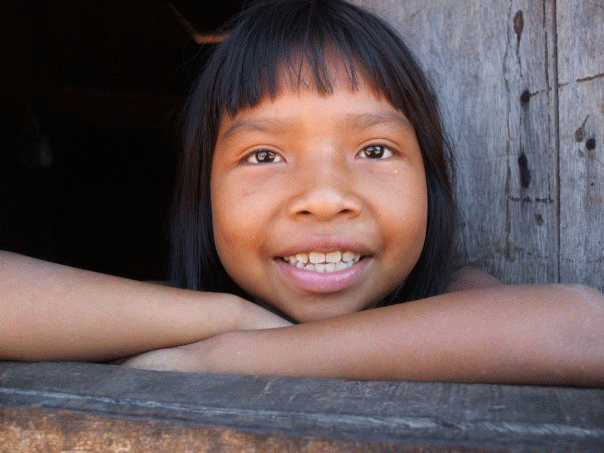
A young Surui girl. (Photo: Bruce Gellerman)
BASCOMB: Even before the recent shake up in the Brazilian government, the chips were already stacked against tribal peoples in the Amazon. Conservationists and indigenous leaders are routinely the subject of death threats and assassinations from loggers, miners, and agriculturalists, all looking to push deeper into the Amazon rainforest.
Back in 2012 I caught up with the leader of the Surui tribe, Almir Surui. The Surui have been living in the state of Rondonia, in the southwest corner of the Amazon for millennia. But within one generation the Surui went from the stone age to the space age in an attempt to document their forest and protect it from developers. Rebecca Moore from Google Earth Outreach was working with them to get an accurate assessment of the carbon locked within the trees in their territory.
MOORE: They’re using Google Android smartphones that allow the Surui to go out into their forest and do a survey and gather information let’s say about the diameter and species of the trees, the locations of the trees, and that ends up being aggregated and estimating the entire volume of forest that they have for which they are compensated.
BASCOMB: Before smart phones came to the Amazon, Surui researchers went out into the forest with GPS units strapped to their back and kept detailed notes in notebooks and on laptop computers. It would take days or weeks to compile all the data. But now….
MOORE: They collect the data and it’s automatically time-stamped, date-stamped, GPS-located, and it goes into their database and the calculations are automatically performed.
BASCOMB: They need to be able to go back to the same trees years later and measure them again to see how much they’ve grown. Then they can calculate how much carbon the trees have absorbed in the process.
MOORE: What they’re gonna do is put barcodes on the trees, and the Google Android smartphone will recognize, oh this was tree 1234, it was this amount of biomass five years ago and this is how much it is now.
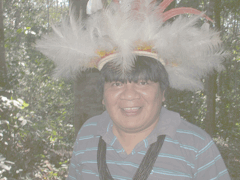
Chief Almir wearing a traditional Surui feather head dress and beads (Photo: Bruce Gellerman)
BASCOMB: So are you telling me that if I walk through their forest, there’s gonna be barcodes on the trees like I’m the grocery store?
MOORE: [LAUGHS] I guess, but the size of the barcode relative to the size of these trees in the Amazon—I don’t think you will notice the barcode. [LAUGHS]
BASCOMB: So far, so good. But this is the Amazon, an extremely hostile environment. It’s hot, it rains a lot, and everywhere you turn there are animals.
MOORE: It turns out that there are leaf cutter ants that like plastic and they chew through the plastic barcodes, so there need to be other experiments with new materials that are more resistant to leaf cutter ants and to apparently the monkeys that like the metal tags.
BASCOMB: So monkeys run off with the shiny metal tags and leaf cutter ants chew up the plastic ones. But in spite of those challenges Chief Almir says they've been able to calculate how much carbon is locked up in their trees – and it’s a lot.
SURUI [THROUGH TRANSLATOR]: We have calculated that the Surui will be avoiding the emissions of about 100,000 tons of carbon into the air every year by protecting our territory and avoiding that it gets deforested.
BASCOMB: 100,000 tons of carbon is roughly equal to the carbon dioxide emitted by 22,000 US cars in a year. At the moment Almir is reluctant to estimate how much money the carbon credits will generate for his tribe. But Rebecca Moore says the mapping they’ve already done actually makes their trees more valuable.
MOORE: You can charge more for carbon that has social and environmental co-benefits. Under various financial mechanisms, if your forest provides livelihood to indigenous people, if it is a natural ecosystem that houses biodiversity, if it has rivers within it, if there’s certain—it’s called ecosystem services—a natural forest, an intact landscape can provide, you can charge more for the carbon in your trees, and so documenting that with the cultural map actually brings this additional financial benefit to them as well.
BASCOMB: The Surui project in the Amazon is the first indigenous REDD project in the world. It’s also the first REDD project of any kind in Brazil, and only the second in the world to get validated. Chief Almir Surui says that the health of his community and the health of the forest are one and the same.
SURUI [THROUGH TRANSLATOR]: My family we cannot live without the forest, much as we cannot live without our culture. We need the forest and our culture to survive and live. What we want to achieve by developing a green economy, developing a sustainable way of life, is guaranteeing the future, guaranteeing the future of the next generations.
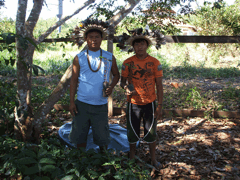
Surui teens hold seedlings for the reforestry project. (Photo: Bruce Gellerman)
BASCOMB: Steve, back then Almir was expecting that his tribe would get UN certification within a matter of months and be up and running with their project to get paid to protect their forest.
CURWOOD: So how did that work out for them?
BASCOMB: Well, not so good, actually. The pressure from loggers in the region was just too much and the Surui had to abandon the tagging project.
CURWOOD: Oh no!
BASCOMB: Yeah, logging is a really serious business there. Chief Almir has had many threats against his life from loggers, to the point that he’s actually had to leave the country several times for his own safety. Ultimately, the Surui were not able to keep enough trees free from the logger’s chainsaws to qualify for carbon credits.
CURWOOD: Well, did they get any help along the way?
BASCOMB: No, it seems not. I’ve exchanged emails with Ivaneide Bandeira, she’s the coordinator of Kaninde, an NGO that has been working with the Surui, and she says the tribe was essentially abandoned by the government. They were no help at all in keeping the loggers at bay. And that was before President Bolsonaro made these changes within FUNAI, that we heard about earlier in the show.
CURWOOD: So that’s making a difficult situation worse.
BASCOMB: Yes, exactly. But Almir and the Surui are nothing if not determined. They are still hoping to get the project back up and running, and in the meantime, they are working on agroforestry to make money from a standing forest. They’ve gotten sustainable certifications for Brazil nuts and a cosmetic oil called babassu. And they are working on getting the same certification for coffee. I plan to keep tabs on this and have more in the weeks ahead.
CURWOOD: OK, sounds good. Thanks Bobby.
BASCOMB: Sure thing.
Related links:
- Ivaneide Cardozo's NGO Kaninde works with the Surui on the REDD forest project
- Indigenous Environmental Network Opposes the REDD Scheme
- Amazon Conservation Team
[MUSIC: Pablo Villegas performs Villa Lobos’ “Prelude No. 1” in the WQXR Café]
CURWOOD: Living on Earth is produced by the World Media Foundation. Our crew includes Naomi Arenberg, Delilah Bethel, Thurston Briscoe, Jenni Doering, Don Lyman, Lizz Malloy, Aynsley O’Neill, Jake Rego, Adelaide Chen, and Jolanda Omari.
BASCOMB: Tom Tiger engineered our show. Alison Lirish Dean composed our themes. You can hear us anytime at L-O-E dot org, iTunes and Google play- and like us, please, on our Facebook page - PRI’s Living on Earth. We tweet from @livingonearth. And find us on Instagram at livingonearthradio. I’m Bobby Bascomb.
CURWOOD: And I’m Steve Curwood. Thanks for listening!
ANNOUNCER: Funding for Living on Earth comes from you, our listeners, and from the University of Massachusetts, Boston, in association with its School for the Environment, developing the next generation of environmental leaders. And from the Grantham Foundation for the protection of the environment, supporting strategic communications and collaboration in solving the world’s most pressing environmental problems. Support also comes from the Energy Foundation, serving the public interest by helping to build a strong, clean, energy economy and from Carl and Judy Ferenbach of Boston, Massachusetts.
ANNOUNCER 2: PRI, Public Radio International.
Living on Earth wants to hear from you!
Living on Earth
62 Calef Highway, Suite 212
Lee, NH 03861
Telephone: 617-287-4121
E-mail: comments@loe.org
Newsletter [Click here]
Donate to Living on Earth!
Living on Earth is an independent media program and relies entirely on contributions from listeners and institutions supporting public service. Please donate now to preserve an independent environmental voice.
NewsletterLiving on Earth offers a weekly delivery of the show's rundown to your mailbox. Sign up for our newsletter today!
 Sailors For The Sea: Be the change you want to sea.
Sailors For The Sea: Be the change you want to sea.
 The Grantham Foundation for the Protection of the Environment: Committed to protecting and improving the health of the global environment.
The Grantham Foundation for the Protection of the Environment: Committed to protecting and improving the health of the global environment.
 Contribute to Living on Earth and receive, as our gift to you, an archival print of one of Mark Seth Lender's extraordinary wildlife photographs. Follow the link to see Mark's current collection of photographs.
Contribute to Living on Earth and receive, as our gift to you, an archival print of one of Mark Seth Lender's extraordinary wildlife photographs. Follow the link to see Mark's current collection of photographs.
 Buy a signed copy of Mark Seth Lender's book Smeagull the Seagull & support Living on Earth
Buy a signed copy of Mark Seth Lender's book Smeagull the Seagull & support Living on Earth

